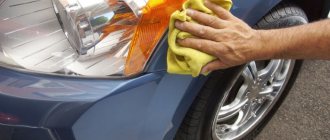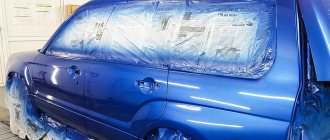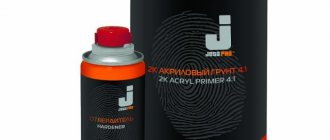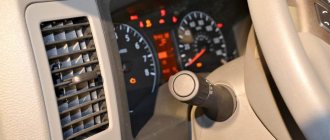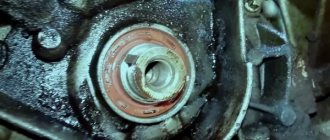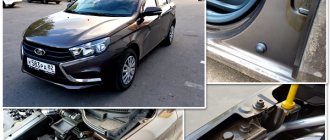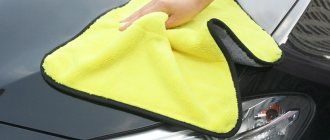Coarse shagreen (orange peel effect) can occur due to insufficiently diluted paint, a large spray gun nozzle, or rapid evaporation of the solvent from the paint.
To remove shagreen after painting, so-called deep abrasive polishing is required. The principle is that a thin layer of varnish is removed with sanding paper P1500 - P2000 using water. If the varnish is well dried, then dry sanding can be used using an eccentric sander and appropriate grinding wheels.
However, the first option is more common. With this method of sanding, the shagreen becomes less noticeable. If you continue sanding the varnish, you can achieve a completely flat surface, without shagreen, but the varnish layer will become significantly thinner, and this is not very good. Trying to completely remove shagreen, you risk rubbing the varnish down to the paint, which will be impossible to fix without repainting.
So, the freshly painted surface is sanded. There is also a point that for sanding it is better to use a hard flat block so that the sanding paper does not smooth out, but “cuts off” the tops of the shagreen. Next, you need to remove all remaining varnish particles from sanding with clean water. To smooth out scratches from P2000 sanding paper, you need to use an Abralon 2000 abrasive wheel, or a 3M Trizact 2000 or 3000 wheel. These abrasive wheels will smooth out the scratches and make the surface uniformly matte. The next step is to use an abrasive polishing paste. You can take 3M paste with a green cap, which replaces the outdated 3M pastes No. 1 and No. 2 (coarse and fine abrasive). It has a special composition and structure that can smooth out and almost completely remove remaining risks. You can read more about polishing in another article.
It is better to use this paste first with a dense circle and medium speed, and then use a circle of medium hardness and increase the speed. For cars with a dark paint color, you need to additionally use a polish that removes circular marks (holograms). 3M comes with this polish in a bottle with a blue cap. Polishing will restore the gloss and all that remains is to apply protective wax.
Reasons for appearance
Shagreen on a car can result from improper painting. And it arises for the following reasons:
- The paint and varnish product was prepared according to the wrong recipe. As a result, the consistency turned out to be of low viscosity, which was not enough for uniform application on the surface of the car.
- The paint manufacturer's instructions were not followed correctly. The wrong solvent may have been used.
- The spray gun has not been adjusted correctly, so the air pressure does not meet the required parameters.
- The spray gun used a very large nozzle.
- The conditions in the box where the car was painted were unfavorable. The air temperature is either higher or lower than normal, which is why shagreen appears when painting and other defects.
- The car paint product was stored incorrectly (at low temperatures). When using such paint, it lies unevenly on the surface of the car.
- The painted parts were not dried correctly and the drying times of the layers were not maintained.
Shagreen on a car can appear even if the car is painted in specialized services. In order to avoid its occurrence, it is necessary to take measures that prevent such a defect.
Required roughness
But there are situations when it is desirable or even necessary to achieve a shagreen effect on the surface to be painted. Walls decorated with shagreen leather look very aesthetically pleasing and attractive. This trend has become quite fashionable recently.
Shagreen effect created intentionally
In addition, using shagreen dyes you can hide some defects in walls and other surfaces. For example, welding seams, kinks, small depressions or local roughness can be easily decorated using shagreen paint. In this case, all defects become less noticeable and seem like an interesting design move. While when painting without shagreen, the irregularities will remain visible and will spoil the overall picture of the interior.
Shagreen has good adhesion to metal surfaces. Therefore, the paint can be used to decorate doors, safes, as well as metal objects and equipment. In addition to its texture that is pleasing to the eye, shagreen paint has protective properties and is designed to protect surfaces from adverse environmental conditions.
Surfaces or objects painted with shagreen have a very aesthetic appearance. In addition, they are extremely pleasant to the touch. And as mentioned above, paint of this type helps to hide many defects and irregularities, turning them into a planned design move.
What to do to prevent a defect from appearing
It is possible to paint a car without the appearance of defects, but to do this you will need to follow some rules and adhere to painting technologies.
It is also recommended to use only high-quality tools in your work, as well as use good paint and solvents.
Many masters highlight the basic requirements that help prevent the appearance of shagreen:
- At the moment when the paint and varnish composition is mixed, the proportions should be strictly adhered to. In order for the proportion to be maintained with greater accuracy, it is necessary to use measuring containers for work.
- A solvent should be used to paint the car and mix the paint. It must match the paint; as a rule, the manufacturer writes on the can which solvent should be used. You also need to know that the solvent is used not only according to the manufacturer’s recommendation, but also depending on the climate, room ventilation and volume of work.
- Also, before painting, you should properly set up the spray gun. It should have a passport with data on pressure and other characteristics. Tool adjustments must be made after any use.
- The temperature for painting a car indoors must meet certain indicators, namely about 20 degrees. A temperature discrepancy of 1 degree is allowed, both up and down.
- Storage of paint and varnish compositions should not be in a humid place, and the temperature should correspond to the data in the paragraph above
It should be noted that shagreen is not so easy to remove from a car. In this regard, you need to be well prepared, since you will need to spend a little money and time.
Elimination of defects
As practice shows, shagreen is often obtained after painting a car. This is due to the fact that it is not possible to follow all the rules when performing the operation. To correct the situation, you have to resort to some methods:
In cases where the shagreen is small and insignificant, it is recommended to use the polishing method. Polishing should be carried out after the paint on the car has completely dried.
Then the shagreen will need to be removed using sandpaper. To work, you need water and the abrasive itself with a grit size of P1200 and P1500. When the main defect has been removed, you need to finish the polishing stage with P2000 and P2500 paper. After cleaning, you need to go over the parts with polishing paste to smooth the surface and give it shine.
If polish cannot remove defects from car parts, you should completely repaint them.
It is worth noting that when repainting, you need to remove all fresh paint and use sandpaper to smooth out and remove defects. After this, you can begin repainting.
Polishing stages
The polishing process after painting can be divided into two main stages:
- grinding - processing the body with sandpaper;
- polishing – rough, intermediate, finishing.
At the first stage, the car is treated with sandpaper, the grain size of which depends on the method: wet or dry. In the first case, it is necessary to properly polish the surface with constant wetting with water, then the paper will not become clogged with dust and will not harm the paintwork. With this option, the work is done by hand.
Then they move on to the second stage - the actual polishing. Before purchasing an abrasive paste, it is advisable to consult with specialists, since its type depends on the thickness of the paint coating. To rough polish, take a harder wheel and apply a coarse abrasive paste to a small surface area. Then they rub it in in a circular motion, if they work with their hands, and if they use a polishing machine, then in a cross-shaped motion.
Intermediate polishing is performed with a medium abrasive compound. At this stage, change the circle to a less rigid one. At the final polishing stage, they work with a non-abrasive paste, having previously removed the previous type of polish with a napkin. At all stages, be attentive to the polishing wheels you use, change them along with the paste in order to achieve an excellent result with your efforts.
What to do if shagreen appears when painting a car?
Shagreen after painting a car
Cases often occur when, after painting a car themselves, car enthusiasts violate an important technological sequence of operations or neglect special recommendations for the use of paint, which are in the manufacturer’s instructions.
The consequences of such actions are most often shagreen. The defect, which has been nicknamed "automotive cellulite", usually manifests itself in the poor merging of all the paint droplets on the surface. Although shagreen does not affect the integrity of the coating, it can seriously ruin its appearance.
How can you remove shagreen with your own hands? Is it possible to prevent such a defect from occurring in a garage? In this article we will try to consider in detail the main reasons for the appearance of shagreen after painting, and also tell you how to get rid of it.
Reasons for the appearance of shagreen
After painting both the car as a whole and its individual parts, shagreen may occur for the following reasons:
- The coloring agent was made using the wrong recipe. The result is a low viscosity value, which is not sufficient for uniform application of the layer over the entire painted surface of the car.
- Failure to follow the manufacturer's recommendations during the manufacture of the coloring agent. The result is the addition of the wrong thinner to the paint (more harsh for such a mixture).
- Incorrect adjustment of the spray gun used. The result is either too low or too high air pressure.
- Using a fairly large nozzle for the spray gun. In this case, defects may appear precisely because the resulting coloring composition is splashed over the entire surface and is not sprayed as necessary.
- Unfavorable microclimate in the working paint booth. Low or high temperatures can cause various defects during painting, including shagreen.
- Failure to comply with the storage conditions of the coloring agent used. When using paint that was stored in a room with a particularly low temperature, the mixture in this case does not spread well over the surface of the car being painted.
- The required time and technology for drying the entire coating between the application of successive layers or in the case of using the air flow of a paint gun were not maintained.
- Shagreen also occurs when painting in specialized automotive services. In order to prevent the occurrence of a defect, it is necessary to know the measures that will avoid its occurrence.
This is interesting: What to do if you lost your driver's license
Spectacular roughness
Car lamp sockets: designation and types
Shagreen is not always an undesirable defect. It happens that this effect is created intentionally. Shagreen decor on the walls looks very beautiful, unusual and stylish; this trend is popular. Silk textured painting allows you to hide minor surface defects. A unique decor not only plays a practical function, but can also pass for an interesting design idea.
To create this effect, a special shagreen powder paint is used. It can be used to process almost any surface; it is a universal material, suitable for both plastered and primed walls, as well as metal pipes and communications. The paint has excellent adhesion and is used for decorating safe cabinets, equipment, and door panels.
The pleasant-looking texture attracts attention, looks aesthetically pleasing and stylish. The composition allows you to protect surfaces from the negative effects of environmental factors
Such properties are explained by the substances included in the coloring composition. Powder shagreen paint allows you to obtain a durable coating, the service life of which is calculated for years. A wide range of shades will satisfy any demanding buyer.
It is worth noting that shagreen paint is resistant to many chemicals and solvents. Therefore, when choosing this material, you need to be prepared that removing it from the surface will be problematic. You should buy paint only from trusted, well-known manufacturers in order to get high-quality and long-term results.
With all efforts to prevent the appearance of unevenness and roughness when painting, the shagreen effect is obtained in most cases of surface painting. The only question is how noticeable this orange peel is, and whether it makes sense to get rid of it, or you can leave everything as it is. Careful surface preparation and the right technology can only minimize this defect, making it as invisible as possible.
How to prevent shagreen from appearing?
Shagreen after poor quality car painting. Click on photo to enlarge.
It is possible to paint a car without causing any defects if all established technologies are followed, as well as using the highest quality tools and materials. Experienced experts advise additionally following tips that will allow you to paint your car efficiently and prevent shagreen from occurring:
- When mixing coloring agents, only the recommended proportions should be used, and measurements will be accurate if you use measuring containers.
- The solvent must be selected in accordance with the manufacturer’s recommendations, as well as taking into account ventilation and climatic factors and the volume of work.
- Correct adjustment of the spray gun, which is carried out according to the pressure indicators and characteristics specified in the personal passport for the product. The spray gun must be adjusted after each use.
- It is necessary to establish and maintain a favorable temperature in the paint booth. The air in the box should be from +19°C to +21°C.
- The place where varnishes and paints are stored should have a completely favorable microclimate. The air should be from +19°C to +21°C.
Removing shagreen and other defects after dyeing is the most labor-intensive and also costly process, in contrast to following the described recommendations and requirements.
How can you eliminate shagreen?
Unfortunately, it is often not possible to carry out all car painting work at the required level. The result of this can be various painting defects, including shagreen. How can you remove defects after painting a car?
Surface polishing
After the paint has dried, you need to clean the entire defective area using absolutely any abrasive material (for example, sandpaper). The abrasive depends mainly on the degree of damage to the car's surface. Polishing is the final process of getting rid of a defect; it creates shine and gloss.
Repainting
In some cases, when polishing does not remove staining defects, it will be important to repaint the entire surface. Before repainting, it is necessary to smooth out the most defective areas with fine-grained sandpaper.
Painting a car without the appearance of shagreen is the rule, not the exception. At the same time, its occurrence is a minor tragedy. Shagreen is only a cosmetic flaw and does not in any way threaten the integrity of the body and coating. The car owner decides whether to remove or leave the shagreen after painting the car; it all depends only on the appearance and degree of the defect.
Painting a car is a rather complicated technical process that requires compliance with all requirements and conditions.
Painting a car without shagreen is quite accessible to any car enthusiast; the main thing is to strictly follow the specified requirements, as well as the recommendations of manufacturers of painting materials.
Shagreen surface effect
The “shagreen” texture is a modern trend in the design of apartments and houses, loved by designers. A very convenient type of painting that hides minor surface defects well and does not require preliminary puttying or plastering - unless, of course, there are potholes and cracks deeper than 2 mm on the walls.
A large selection of colors and shades makes this textured paint very popular. In addition, it is applied to the surface only once, which greatly facilitates and simplifies painting work.
Textured compositions are produced based on water-based paints. They are prepared in a special paddle mixer, loading it with synthetic-based water-based paint and fillers - potassium glass and marshallite. The prepared composition is kept for about half an hour, after which it becomes completely homogeneous.
The surface is first thoroughly cleaned and primed with a synthetic paint composition. After the primer has dried, paint is applied in one or two layers 1-2 mm thick. You can use a spray gun or, for small areas, a paint roller.
There is no need to try to cover large surface imperfections with just textured paint. If there are large depressions and irregularities on the base, they will still have to be repaired first. Now they produce textured plasters that can be used for this purpose. After drying, the plaster is coated with acrylic paint, and the shagreen effect is preserved.
Powder formulations
Powder compositions are used to paint metal surfaces. They also give a good shagreen effect, masking scratches and unevenness. Here you need to focus on the object that needs to be decorated.
Polyester paint shagreen is more suitable for products intended for outdoor use. Such compositions withstand the vagaries of the weather well and protect the object from the negative effects of atmospheric phenomena.
If the product or structure is exposed to chemicals, then it is better to use epoxy-based paint. Mixed epoxy-polyester paints are used for indoor structures.
Based on textured compositions, you can achieve a very interesting “Antique” effect. The fact is that the protrusions on the painted surface are slightly different from the color of the base. The result is original shades, given the variety of colors of powder paints.
Paints with a shagreen effect are wear-resistant, abrasion-resistant, do not fade, significantly save money on repairs and have a unique, original appearance. The use of such compositions in the design of premises, metal products and structures gives them strength, resistance to the external environment and a special charm.
Effective ways to remove shagreen
When painting a car or part of its body, sometimes a cosmetic defect occurs in the form of a small uneven surface (shagreen), which looks like an orange peel. The appearance of such a defect is possible at any stage of applying paint and varnish mixtures, and even during varnishing, if they are carried out in violation of the technological sequence or without following the recommendations contained in the instructions for the paint.
Irregularities can be either small in size (fractions of a millimeter) or very significant in size (0.5-0.7 centimeters). In addition, the visual visibility of defects is affected by the color of the coating. White shagreen is noticeable on a car much more than similar flaws on a dark-colored body. Therefore, owners of light-colored vehicles are often concerned about how to remove shagreen.
Historical reference
People have always sought to decorate their home furnishings and personal property to indicate their high status in society. The word "shagreen" comes from the French chagrin. The term came to Europe from Turkic languages meaning “horse rump”. This is rawhide from the backs of donkeys and horses. During rough dressing, the material was covered with a relief texture.
Antique silver elephant figurines with shagreen leather
Back in the 2nd century, Chinese soldiers used shagreen to decorate their bows. By the 17th century, decorative coverings had become popular in Europe. It was made from stingray skin or shark skin. A new round of interest in unusual textures arose in the 1970s. The decor became part of Art Deco style interiors.
Today, shagreen is a type of paper, leather, and textured paint. The same word is used to describe coloring defects that occur when technology is violated.
Reasons for the formation of shagreen
Beginner painters very often encounter the problem of shagreen paint after painting a car. Of course, adherence to technology and a responsible approach to work will help minimize the possibility of defects. But in order to completely get rid of shagreen, you will also need ideal atmospheric conditions with a certain level of humidity and temperature. Among the main factors that contribute to the emergence of such shortcomings are the following:
- Incorrect adjustment of the spray gun. If the gun nozzle is not at the optimal distance, then this location often leads to paint splashing. Therefore, it is important to select the correct diameter of the spray hole of the device and pre-adjust the air stream.
- Inconsistency of the microclimate in the box. To ensure uniform drying of paint and varnish products, it is necessary to adhere to the temperature regime. So, if the hangar is too hot, this can lead to increased evaporation of the solvent and premature hardening of the paint. Otherwise, it will dry very slowly, forming clumps.
- Uneven operation of the compressor. The consequence of the air “spitting” of this electrical apparatus is the uneven distribution of enamel and the formation of shagreen.
- Chemical incompatibility of the solvent with varnish or primer. The issue of choosing a solvent that matches the primer and varnish is extremely relevant. And if this factor is neglected, all the work can go down the drain.
- Insufficient paint viscosity. This problem can occur if the technology for preparing its composition has been violated, or the wrong container has been selected for measuring the dosage of components. Painting a car is a very serious undertaking, and here you cannot add hardener and thinner “by eye” without adhering to the proportions.
- Storing the coloring composition in a cool place.
The final result depends on the quality of the work at each stage. Priming, enameling, varnishing of the car body - all this must be performed at the highest level. Even a minor mistake in one of the steps can lead to a defect appearing after painting and drying is completed.
Methods for removing shagreen
Professional painters know very well from their own experience how to remove shagreen. There are two main ways to remove it:
The first method is more preferable, and if the situation with poor-quality paint application can still be corrected, then it is used. The second option is an extreme measure that the master has to take in case of complete failure.
Polishing
Minor irregularities on the surface of the car appear even if painted in conditions close to ideal. Simple roughness can be removed by cleaning using any abrasive materials. At the initial stage of polishing, sandpaper with a grain size from P1200 to P1500 is used: a small rubber or wooden block is wrapped in sandpaper and a smooth, uniform surface treatment with defects occurs. During the process, it is periodically necessary to wash off the resulting dust and microparticles of paint from the working surface. To do this, it is recommended to use clean distilled water, the excess of which is removed with a rubber sponge.
After rough processing, finishing matting is carried out with abrasive paper numbers P2000 or P2500. At the final stage, special pastes are applied to the body, after which the surface acquires gloss and shine.
This is interesting: What happens if you switch to reverse gear while driving: video
Also, to remove shagreen, they produce special Trizact grinding discs for polishing machines. They have a soft backing onto which abrasive particles with a grit size of P2000 or P3000 are sprayed. Such devices greatly facilitate the work and do not leave behind deep scratches.
Repainting
If the paint applied to the surface unsuccessfully and the white shagreen remains even after mechanical treatment, you will have to start work from the very beginning. In this case, it will be necessary to completely remove the old coating so that its flaws do not appear in the future. In addition, the previous protective material may be incompatible with the new one. Therefore, repainting is a very labor-intensive operation.
Subtleties of the process
Elimination of smudges should be carried out on a dry coating. If the paint is not completely dry, this can lead to separation of the bead along with the paint layer. Cavities and enamel detachment may occur. Place masking tape around the defect. Use a blade to cut off the influx, starting from the top to the base. Then they move on to sanding. To do this, wrap a rubber block in sandpaper and moisten it with a soap solution. Then they change the skin to a less grainy one. Too large smudges can be cut off while they are still wet. After removing the buildup, apply a thin layer of putty and after 20 minutes sand it using the technology described above. It is much easier to remove small smudges. If it is a small part, it can be turned over in the opposite direction to the direction of the leak. If the smudge is barely noticeable, you can touch it up a little.
Alternative methods of applying paint to a car body
Powder painting of cars will help to avoid the possibility of unevenness and cosmetic defects as much as possible. This technology makes it possible to obtain high-quality polymer coatings with minimal material consumption and good performance properties. And special additives that regulate spreading and have good corrosion resistance provide reliable protection to the body metal.
The powder paint method has a number of undeniable advantages, which has led to the popularity of its use in the modern automotive industry.
Forget about fines from cameras! An absolutely legal new product - NANOFILM, which hides your license plates from IR cameras (which are installed in all cities). Read more about this at the link.
- Absolutely legal (Article 12.2.4).
- Hides from photo and video recording.
- Installs independently in 2 minutes.
- Invisible to the human eye, does not deteriorate due to weather.
- 2 year warranty
Shagreen after painting a car - how to deal with the problem?
Painting a car is a complex and specific task that needs to be done professionally. If the painting process is done incorrectly, after its completion you will have to remove a lot of unpleasant little things. This will delay the work and make the appearance of the machine of lesser quality. Lumps of paint, unpleasant streaks and drops, dots and an uneven layer - all this happens when you approach the car inappropriately or in the wrong conditions. Shagreen when painting a car sometimes occurs even among specialists with extensive experience.
Shagreen is an “orange peel” that can be very noticeable or quite fine. If painting is done by a specialist in a chamber, then this effect will not be noticeable. If you use high-quality materials and good equipment, you can completely avoid such a nuisance. Such effects can be removed either by redoing the work in a certain area or without painting. Shagreen leather should not be allowed to appear on a beautiful car. Let's take a closer look at this point.
Why might shagreen appear on your car?
Lumps of paint material on a car can be seen during unprofessional painting. Incorrect distance of the gun from the metal or incorrect hand movements will result in poor paint application to the surface. But this is not the only reason for such trouble. The performer’s limited experience should always be taken into account, not allowing a beginner to carry out responsible work on expensive areas. Shagreen can appear on car body parts for the following reasons:
- low quality paint - in this case it will be very difficult to remove this defect by any means;
- poor compressor performance during painting work, low or too high pressure;
- a clogged spray gun that has not been washed properly for a long time, poor atomization;
- poor-quality metal preparation before painting, textured putty surface;
- poor quality of the primer used to expose the part before applying the paint and varnish material.
The choice of method to remove the effect depends on the cause of the appearance of shagreen. There are two options for car processing to eliminate such consequences. This is a treatment that involves removing a layer of paint, and also without repainting the car. If shagreen appears on the entire surface of the car after painting, you will have to take a more serious approach to eliminating the problem. Most likely, the preparation was performed poorly.
Let's sum it up
An unpleasant shagreen defect on the body of your car can occur when painting metal parts. Most often, this effect is present when an inexperienced specialist is working, but it can also arise for other reasons. It is important to notice the “orange peel” on body parts in time and carry out restoration to eliminate the unpleasant visual defect. It can be eliminated by polishing or repainting the area.
Of course, it is better to avoid poor-quality painting, since it will be very difficult to remove this nuisance without visible visual consequences on the car. Sometimes specialists have to completely repaint the entire part on which the shagreen appeared. Even if such an unpleasant situation arises when painting a car, everything can be eliminated. Read the instructions for combating this phenomenon and carry out all procedures efficiently and without unnecessary nerves. This will help make the car beautiful again.
Eliminating the defect - the main methods of combating without painting
To save your car from shagreen and not have to repaint the car again, spending a lot of money on materials, you can try to eliminate the defect by polishing. But in this case, the polishing technology will be slightly different than with standard refreshment of the paintwork. It is important to observe all the features and stages of the polishing process:
- Wait a day after painting so that the paintwork adheres properly.
- Use 1500 grit sandpaper and matte the surface.
- You can use wash technology to matt the top layer.
- Next, apply polishing abrasive paste to the damaged area.
- Use a polishing machine with a soft felt pad to polish.
- Repeat the procedure after finishing the paste on the area several more times.
All that remains is to wash off the unused remnants of the paste and evaluate the result. But if the painting was done too poorly, polishing work will not always help correct the situation. Sometimes you will have to use a drastic method to correct errors and repaint part of the car.
Polishing
After leveling the surface, apply a small layer of 3m polishing paste to the paintwork; it is sold by weight and requires very little to polish. Then we take the sander and start polishing, constantly moving the sander from side to side. Polishing should be carried out evenly, without holding the machine in one place for a long time.
Before polishing, all surfaces of the car body should be covered with a protective layer of special paper, all glass, rubber seals and plastic parts, securing the paper with masking tape. You should also close all emblems and holes in the radiator grille, and it is better to remove the turn signals and mudguards. If possible, the interior and engine compartment should be sealed; it is advisable to prevent dust from polishing from getting there.
Removing the “orange peel” with high-quality painting
Even many experts with extensive experience sometimes wonder how to remove shagreen after painting a car. This is a rather difficult task, which is performed individually in each individual case. To get rid of troubles on the surface of metal parts, from various bumps and pits, you will have to perform the following procedures:
- Wash the paint down to the primer, leaving no old enamel on the damaged area.
- Assess the quality of the soil and, if necessary, wash it down to metal.
- Perform metal processing to eliminate unpleasant effects in the future.
- Open up the area with a new layer of primer and wash the top part again for a smooth surface.
- After the primer has dried, paint the area using high-quality enamel.
Also, after completing all the processes, it is necessary to thoroughly polish the paintwork, making sure that there are no unpleasant effects. The car will look great if all processes are carried out efficiently. But in the case of local painting, other problems are possible. If the transition to the old coating is not done professionally, you will have to deal with a visible spot of local paint. So this task is also performed only by specialists.
